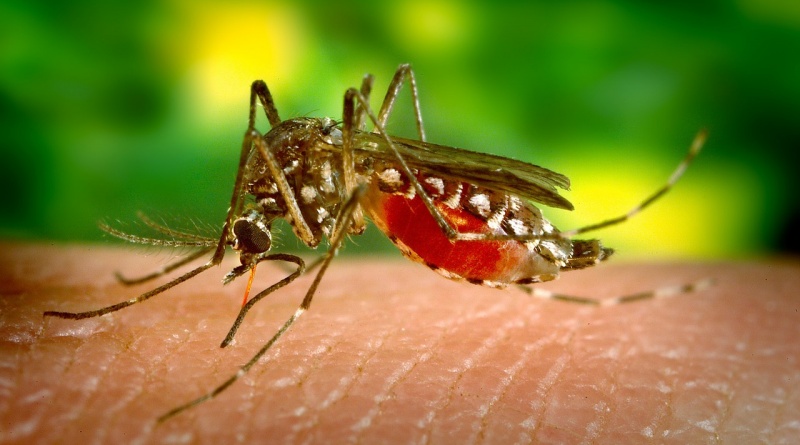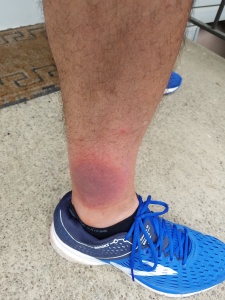How Bug Bites can be a Nuisance
My cellulitis symptoms were difficult to treat.
My cellulitis infection was inflamed, red and itchy skin. The cellulitis symptoms was not painful but embarrassing.
Sound familiar?
Perhaps you’ve tried everything to eliminate your cellulitis infection. I was on three different medications in a thirty day time period to eliminate it. It was pretty challenging since I continued to compete in 5000 meter running races,
I was on: 1. Doxycycine 2. Sulfameth/TMP800/180MG 3. Cephalexin. I then had to get an IV because the concern of it red-lining to an organ was very possible. The infection had gotten life-threatening.
Cellulitis is a potentially dangerous bacterial infection that affects the deeper layers of the skin, including the dermis, or second layer of skin, and the subcutaneous tissue, or fat and connective tissue that form the bottom layer of skin. (The top layer of skin is called the epidermis.) In my case, it has reached the lymph nodes in my legs and now my body was in an all out fight.
Cellulitis can develop a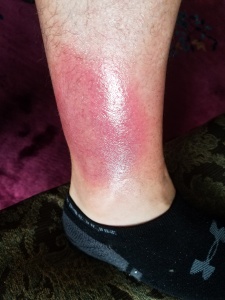 ny where on the body, but in my case as an adult, it affected me on my lower leg and most commonly affects the skin of the lower legs. In children, cellulitis often affects the face and neck.
ny where on the body, but in my case as an adult, it affected me on my lower leg and most commonly affects the skin of the lower legs. In children, cellulitis often affects the face and neck.
Did you know that about 14.5 million people in the United States develop cellulitis each year. I had no idea and I treated it as such. I ignored it, I thought, “It’ll go away. I’ll just rub some antibiotic lotion on it.”
“Cellulitis literally refers to inflammation of the skin,” says , L. Dunning PA at Unity Hospital / Rochester Regional Health Emergency Department , a board-certified dermatologist
“It appeared in the skin as an expanding pink and red patch that feels warm and hard, and sometimes tender to touch. It was pretty angry.
My cellulitis started with an insect bite or in any break in the skin, including a minor scratch or that allows bacteria to penetrate to the deeper layers of skin. It’s definitely rare in my case being very healthy young adult. Cellulitis is more common among elderly people and in people with weakened immune systems, chronic skin conditions that cause breaks in the skin, chronically high blood sugar levels, or obesity. I guess my hard running and speed work contributed to weakened immune system.
Systemic antibiotics — oral antibiotics or, in severe cases, intravenous antibiotics — 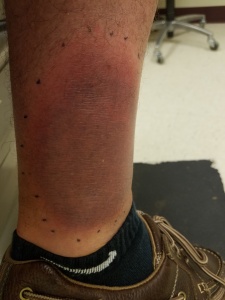 are needed to treat cellulitis. Because cellulitis affects the deeper layers of skin and tissue, topical antibiotic ointments are not effective at treating cellulitis.
are needed to treat cellulitis. Because cellulitis affects the deeper layers of skin and tissue, topical antibiotic ointments are not effective at treating cellulitis.
Cellulitis that goes untreated can spread to the lymph nodes and the bloodstream and quickly become life-threatening.
Given the serious nature of cellulitis, it’s important to seek medical care if you develop symptoms of the condition — even if you’re not sure that’s what you have.
Causes and Risk Factors for Cellulitis
“Cellulitis is usually caused by a variety of bacteria, most predominantly staphylococcusand streptococcal species that live on the skin. These bacteria invade below the skin through abrasions and cuts, and infect the tissues beneath the skin, causing an inflammatory response,” says L. Dunning, a Physician Assistant at the Unity Hospital / Rochester Regional Health Emergency Department in Rochester, NY.
Staphylococcus (“staph”) bacteria on the skin can also cause boils, or pockets of pus that develop in a hair follicle or oil gland, and both staph and streptococcal (“strep”) bacteria can cause impetigo, a highly contagious skin condition that causes crusty, red sores, usually on the face, arms, and legs.
The doctors alerted me to their concern of getting a staph infection. While staph and strep can live harmlessly on your intact skin, but any type of open sore on your body can allow the bacteria in and put you at risk of developing cellulitis, says Shainhouse.
Of course, many people sustain many minor skin wounds over the course of their lives and never develop cellulitis. But certain conditions place people at increased risk for cellulitis. Such conditions include:
- Advanced age, which is associated with a weaker immune system
- A disease that weakens the immune system, such as an autoimmune disease
- Use of a medication that suppresses the immune system
- Injection of illicit drugs
- Impaired lymphatic drainage
- Overweight or obesity
There’s also the risk of cellulitis if you have a skin condition like eczema or athlete’s foot that can cause dryness and itchiness and breaks in the skin, providing an entry point for bacteria. In my case, I have never had anything like this before.
Having had cellulitis once also puts me at higher risk of developing it again.
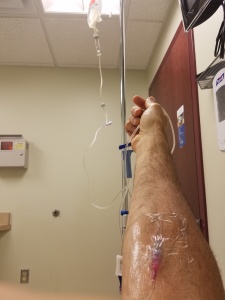
How to Prevent Cellulitis
One of the best strategies for preventing cellulitis is to practice proper first aid when you have a skin injury.
For a minor cut or scratch, that generally means cleaning and covering the wound yourself or with the help of a companion.
But if you have a cut that is deep (¼ inch or deeper) or large, a puncture wound (a tack or nail in your foot, for example), an animal or human bite, a burn or scrape over a large area of your body, or a wound that continues bleeding after 10 or 15 minutes of direct pressure on the wound, you should seek medical attention from your doctor, in the emergency department, or an urgent care center.
First aid for a minor skin injury is as follows:
- Stop any bleeding by applying direct pressure to the wound, ideally with a clean cloth.
- Wash the wound to remove dirt and debris. Use warm soapy water, if it’s available. If you’re not near modern plumbing facilities, use the cleanest water you can find to thoroughly rinse the wound. Scrub gently with a clean washcloth, if necessary. If you cannot get all of the dirt out of a wound, you should see a doctor to fully clean the wound.
- Dry the wound and apply a thin layer of a topical antibiotic ointment, if desired.
- Cover the wound with a bandage to keep it clean and lower the risk of dirt and bacteria entering the wound.
- Change the bandage daily until the wound heals.
Special Precautions for People With Diabetes
Though I don’t have diabetes, I know many people who do. I hear many stories of there difficult experiences with this disease. People with diabetes, in particular, “should take meticulous care of their feet and be aggressive with treating even minor skin issues,” says Dr. Adalja. “Athlete’s foot (fungal infections on the feet) can cause skin to be more prone to bacterial infection, so this should be treated promptly. Also, they should receive routine podiatric care.”
If you have diabetes, examine your feet daily for redness, areas of warmth, signs of pressure or rubbing from shoes, blisters, or injuries of any type. Apply moisturizer to your feet to prevent cracking, but avoid putting moisturizer in the areas between your toes. In addition, keep your toenails and fingernails trimmed to prevent injury from scratching.
Reducing Cellulitis Risk
Addressing the underlying risk factors for cellulitis can also help to prevent it. Such measures might include:
- Losing weight if you’re overweight
- Quitting smoking if you smoke
- Restricting alcohol consumption to no more than one drink per day for women and no more than two drinks per day for men
Spotting an Infected Wound
Even with the best first aid, infections can still occur. In this case, early detection is key to avoiding serious complications. Signs of an infected wound include:
- Increasing redness and pain
- Pus or oozing liquid at the site of the wound
- Swelling
- Tenderness
- Itching
Cellulitis Signs and Symptoms
Cellulitis can develop quickly and can lead to serious consequences, so it’s important to seek medical treatment quickly if you see signs or have symptoms of this type of infection.
As mentioned previously, cellulitis most often occurs in the legs in adults and, according to Unity Hospital PA, it typically occurs in one leg at a time, not both at once.
Common symptoms of cellulitis include:
- Skin redness
- Swelling
- Pain or tenderness
- Skin that’s warm to the touch
- Fever
- Red spots
- Skin dimpling
You may not notice warmth or pain until you touch or press an area affected by the infection. Some people develop other symptoms before there’s a change in the appearance of their skin, such as chills or fatigue.
“In more severe cases, additional clinical features may include blister formation, pustules (bumps on the skin containing pus), and necrosis (skin breakdown),” Shainhouse says.
Severe infection can also cause cold sweats, nausea, difficulty thinking, a fast heartbeat, and low blood pressure.
Cellulitis usually doesn’t go away on its own. I learned that first hand. It has been an expensive lesson.
Diagnosing Cellulitis
A doctor can often diagnose cellulitis simply by examining the skin, although blood tests and a blood culture may be used to confirm a diagnosis.
“Some common mimickers of cellulitis include venous stasis dermatitis, contact dermatitis, eczema, an insect bite reaction, shingles, deep vein thrombosis (DVT), vein inflammation, and gout,” says Shainhouse.
It’s also important to rule out necrotizing fasciitis, a bacterial infection that can quickly destroy the tissue beneath the layers of skin. This is the condition commonly referred to as “flesh-eating disease.”

